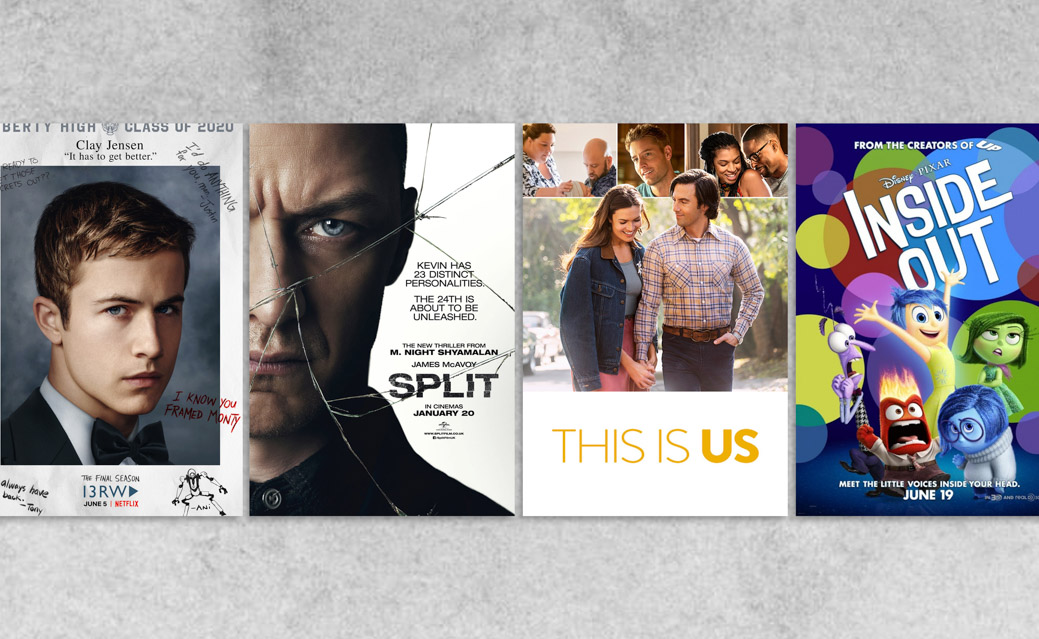Harmful versus helpful portrayals of mental health in film
Various films and television shows depict mental illness, but not all of them do it right.
13 Reasons Why (Harmful)
Dalainey Gervais, Associate Features Editor
CW: Sexual assault and suicide
For a series supposedly about mental health awareness for teens, 13 Reasons Why spends four seasons romanticizing suicide and self-harm. This Netflix original, and one of their most controversial series, features Hannah Baker (Katherine Langford)—a depressed high school student who left behind seven cassette tapes containing 13 audio recordings. Each tape was assigned to a different classmate, listing them as reasons for her suicide. Throughout the series, Clay Jensen (Dylan Minnette) becomes obsessed with uncovering Hannah’s reasons, while dealing with depression and anxiety himself.
Each classmate on the cassette tapes has a dedicated episode that dives into their state of mind before and after Hannah’s death, highlighting the diverse ways people grieve— which is arguably the only positive thing about the show.
Inspired by the eponymous book, the Netflix series first aired in 2017, and was produced by Selena Gomez as an attempt to spark mental health conversations among teens. Ironically, a study published in the Journal of the American Academy of Child & Adolescent Psychiatry demonstrated a rise in adolescent suicide rates in the United States as a direct result of the series.
13 Reasons Why showed explicit scenes of the main character’s sexual assault and suicide. The portrayal of Hannah’s death by Langford was not only graphic, but it romanticized suicide as many viewers believed that the actress looked at peace.
Almost two years after series’ original release, Netflix removed the suicide scene, added more content warnings, and suggested teens watch the show with an adult. 13 Reasons Why is not a story of high school teens facing their mental health challenges; it is a harmful story of revenge.
Split (Harmful)
Whitney Buluma, Contributor
The psychological thriller Split follows Kevin Wendell Crumb (James McAvoy), who has dissociative identity disorder (DID) and 24 distinct identities. Since DID is relatively uncommon—around one per cent of the population suffers from it—any media portrayal can strongly shape the public’s view of the disorder. Instead of approaching DID with the sensitivity and care it deserves, writer and director M. Night Shyamalan recycles the frustrating cinematic trope of depicting people with mental illness as violent and unpredictable.
At the surface level, the movie’s message seems empowering: people with mental illness can do extraordinary things; they are on the next rung of the evolutionary ladder. However, Split irresponsibly presents Kevin’s superhuman identity ‘The Beast’ as a remorseless villain, when really, people with DID often hide their mental illness and are far more likely to hurt themselves than hurt others. With this portrayal, the movie downplays the humanity and suffering of those with DID.
The Beast also fixates on “purity” of the heart, declaring that “the broken are the more evolved.” By fetishizing suffering in this way, Split positions trauma as beneficial or even desirable. In the end, mental illness and trauma in Split exist as mere plot devices, useful only for shock value. The movie complicates the already murky public understanding of DID and inadvertently perpetuates stigma against those with mental illness.
This Is Us (Helpful)
Delaney Rombough, Contributor
The Pearson family is no stranger to mental health issues. On the outside, the Pearsons appear to be a normal and neat family, but they all hide their problems at home. Kevin (Justin Hartley) struggles with alcoholism and addiction, Kate (Chrissy Metz) deals with body image and eating disorders, and Randall (Sterling K. Brown) deals with anxiety and panic attacks. Sometimes these mental health issues are major plot lines, and other times, they linger in the background. In early seasons, these characters struggle alone, but as the show progresses, the siblings begin to talk about these issues with each other and with their partners—a great first step.
The siblings deal with their mental health in their own way, which is healthy most of the time, whether through support groups, medication, or therapy. One of the most profound moments in the show is Randall deciding to go to therapy, simultaneously choosing a Black therapist who would better understand his experiences as a Black man. This shows Randall’s commitment to getting help in a way that works for him.
The Pearsons are lucky that when they encounter these challenges, they are often met with nothing but love and support, even though their public image and pride make them hesitant at times. A positive depiction of dealing with mental health issues is important in media because when we see normal people—even fictional ones—take steps to deal with their problems, we feel like we can do that too.
Inside Out (Helpful)
Danica Teng, Arts and Entertainment Editor
It is not always easy for someone to control their emotions, and sometimes, emotions control them instead. In the case of Disney and Pixar’s animated film Inside Out, there are exactly five emotions that control a person—Joy, Sadness, Fear, Disgust, and Anger.
Inside Out looks inside the mind of 11-year-old Riley (Kaitlyn Dias), who just moved to San Francisco and is forced to start a new life. Riley’s personification of Joy (Amy Poehler) does everything she can to make Riley happy, even if that means shunning Sadness (Phyllis Smith) as much as she can.
After an accident leaves Joy and Sadness locked out far from the control room, located inside Riley’s mind, adventure ensues, reflecting chaos out in the real world as a result. When her emotions are a mess, viewers see the realistic strain on a young child who is suddenly faced with change and how it affects her mental health.
The film manages to create magic with its comedic and colourful journey, but at the same time, Riley’s story shows an honest portrayal of humanity that teaches you to understand and embrace all your emotions. Inside Out explores the balance of mental health and reminds people that every part of who they are matters.



